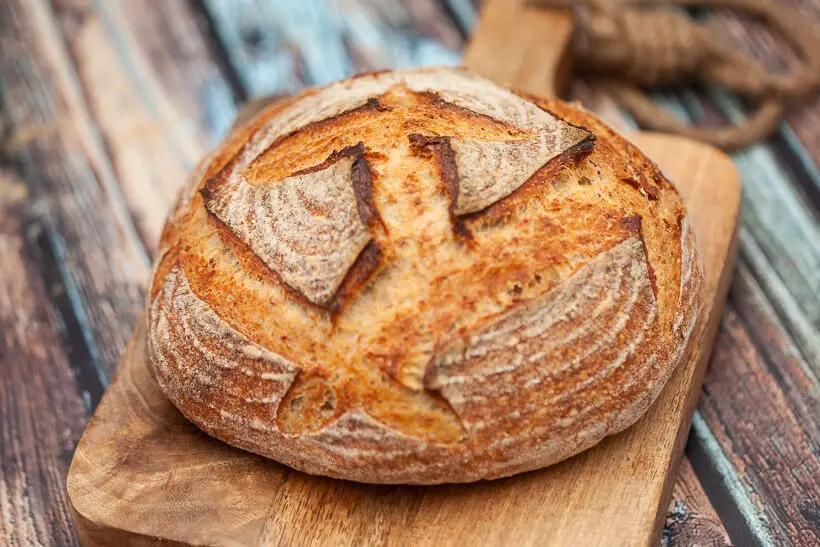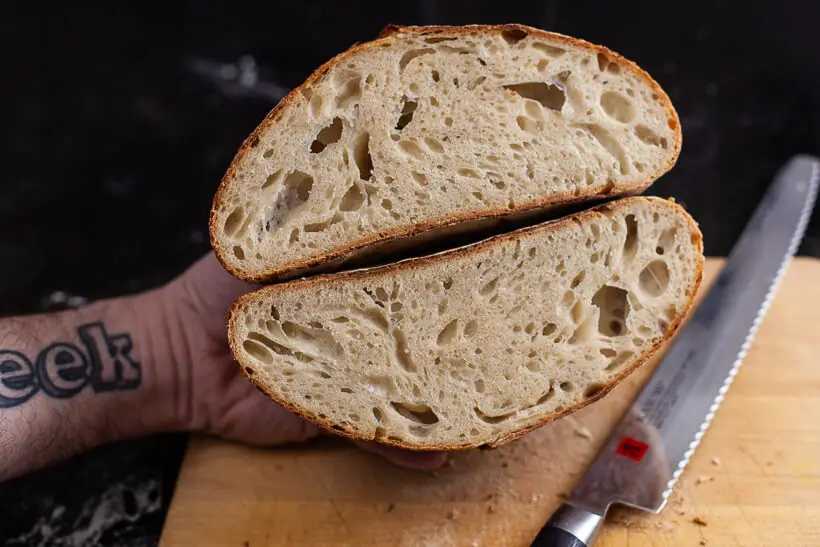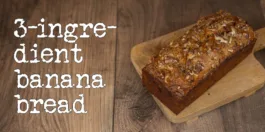Making sourdough bread involves a lot of different techniques and a long list of things to do. Looking at the dough, touching it, waiting for it, stretching and folding it, and a lot of other things. Sometimes you have other things to do, but you still want a fantastic sourdough bread with a holey crumb and a dark, crispy crust. Here is the solution. This is my recipe for the world’s easiest sourdough bread.
I love to bake. Cakes are fun, but bread… bread is everyday food. A day doesn’t go by, without me eating bread. My favorite is sourdough bread. The crunch, the tangy and well-developed taste. Yum.
If you are just here for the recipe, you can easily jump to it by pressing this button:
Go to recipeI’ve loved baking since I was a child
I’ve been baking since I was nine years old and I found my mother’s blue baking book. This is a book that was probably in every home in the 1970s in Denmark. One day after school I grabbed the book and followed the recipes. I don’t remember what recipe it was, but I do remember my Mom being excited about coming home to something home-baked and possibly less excited about the near-exploded kitchen.

Since then I’ve baked a myriad of things. Layer cakes, bundts, cakes, muffins, and buns for my and my kid’s birthdays. Every kind of bread for everyday use. The last year I’ve become pretty obsessed with sourdough and I’ve taught myself to make the most delicious bread with just three ingredients (flour, water, and salt).
You need an active sourdough starter
To bake this bread, you will need to have an active sourdough starter. You are in luck though, because I have made my own guide on how to make your own sourdough starter right in your own kitchen.
Why ‘the world’s easiest sourdough bread’?
The biggest problem for me, when it comes to baking sourdough bread, is that I have to use an entire day to make one bread. It’s super nice and meditative, but I don’t always have that kind of time to spend.

That is the reason that I’ve developed a recipe for the world’s easiest sourdough bread. It requires about 20 to 25 minutes of active work. The rest of the time the dough will just be hanging out on the kitchen counter, in the fridge or in the oven.
The tools you need to make the world’s easiest sourdough bread
When you create things you need tools. I’ve assembled a list of tools you need when you create sourdough bread.
Ad links! Most of these links will give me a bit of commission if you buy them. If you are not interested in doing that, find the tools using your favorite search engine.
As a minimum you will need:
- A good bowl – This bowl is incredibly beautiful, but whatever you have in your kitchen that is big enough to hold the dough
- A bench scraper – This is used to move the sticky dough around and also to help shape it
- A dutch oven – You need a dutch oven (basically a pot that can go into the oven), because then you won’t have to have to make steam the oven because the bread will essentially be steaming itself
- A lame – You need a super sharp knife to score the dough. This one uses a razor blade that can be replaced
- A good oven – Preferably one that can get super hot. I have one that can go to 300°C/572°F that can also steam, which is quite basic in features, because I want to do everything manually
The formula of the world’s easiest sourdough bread
This is a pretty simple bread. 80% high-protein flour for good oven spring, 20% whole-grain wheat flour for delicious taste, and 75% hydration for lots of holes in the crumb.
| Weight | Ingredient | Baker's Percentage |
|---|---|---|
| 100g | sourdough (100% hydration) | 10.0% |
| 760g | bread flour | 76.0% |
| 190g | whole-grain wheat flour | 19.0% |
| 700g | water | 70.0% |
| 22g | salt | 2.2% |
If you want to change the formula, you can do it here in my bread calculator.
Great sourdough bread takes time
There is no doubt. Great bread takes the time that great bread takes, but it is absolutely possible to cut down on the amount of work.
My regular method for making sourdough bread consists of a lot of steps:
- Create and mature a levain (3-4 hours)
- Autolyse (½-1 hour)
- Mixing the dough (20 minutes)
- Bulk fermentation including stretch and folds (3 hours)
- Diving and shaping the dough (30 minutes)
- Retard (8-10 hours)
- Baking (1½-2 hours)
All that will be replaced by these easy steps:
- Mixing the dough (10 minutes)
- Bulk fermentation on the kitchen counter (8-10 hours)
- Dividing and shaping (25 minutes)
- Quick retard while the oven is heating (1 hour)
- Baking (1½-2 hours)
That means that you can just mix the dough at night and shape and bake it the next morning.
All you need is one advanced technique
The only advanced technique you need for this recipe is shaping the dough. In this video, I use my hands to fold the dough, but when you get to higher hydrations you should use your bench scraper.
You can get a good idea of how to do it here:
The conclusion of the world’s easiest sourdough bread
Compared to how you create classic sourdough bread, this is an extremely easy recipe. It really delivers in both crust, crumb and taste.

It is not going to be the only sourdough bread in my arsenal, but it is really great to have a great bread that can be done with a minimum of work and time
The active time investment is really so much lower than the regular sourdough bread, so it will be easy to find time to bake on a more regular basis now.
Please share on social media
This is my recipe for the world’s easiest sourdough bread. I hope you will try to make it. If you post it on Instagram please tag med as @foodgeek.dk so I can see it. That would make me very happy.

The world’s easiest sourdough bread
Ingredients
- 760 grams bread flour
- 190 grams whole wheat flour
- 700 grams water
- 100 grams sourdough starter
- 22 grams table salt
Instructions
Ready your sourdough starter – in the morning
- Feed your starter, so it is ready to be used in the evening.
- You need enough starter to use 100 grams and something to continue your sourdough starter.
- I usually take 50 grams of unfed starter, 100 grams of bread flour, and 100 grams of water.
Make the dough – in the evening – about 21:00/9 p.m.
- Put 100 grams of starter and 700 grams of water in a big bowl. Mix until the starter is dissolved.
- Add 760 grams of bread flour, 190 grams of whole-grain whole-grain wheat flour, and 22 grams of table salt
- Mix the dough with your fingers until it is well mixed.
- Put a wet dishcloth over the top and leave it until the following day.
- Note that the recipe assumes your kitchen to be about 21°C/70°F. If it is a lot warmer, the dough may be ready sooner, and if it's a lot cooler, it might take much longer.
- The dough should be about doubled in size and jiggle slightly when wiggling the bowl.
Divide and preshape – next morning – between 6:00/6 a.m. and 8:00/8 a.m.
- Pour the dough onto an unfloured table and divide it in two using your scraper.
- Grab a piece of dough and push your scraper under the front of the dough. Lift it and fold it over the dough away from yourself.
- Repeat from the top, from the left, and the right. That creates tension on the dough that is facing the table.
- Using your scraper, in one swift motion, push the scraper underneath, lift the dough and turn it upside down.
- Put your scraper behind the dough and drag it towards yourself. Use your other hand to guide the dough so that the front of the dough is pushed underneath the ball, thus creating tension on the top of the dough. To release the scraper, pull it backward quickly.
- Now put the scraper in front of the dough and push forward and turn it around until the scraper is behind the dough again. Repeat these two steps until you have a suitable ball.
- Repeat with the other piece of dough and let the dough balls rest on the kitchen table for 15 to 20 minutes.
- While waiting, mist your bannetons and sprinkle with rice flour.
Shape the dough and refrigerate
- Shape the dough as described above, making sure the surface is very tight.
- Using the scraper, flip the dough into the banneton. Seal it using a plastic bag and put it in the fridge.
- Repeat with the other dough ball.
Bake the bread
- Put a dutch oven in your oven and turn the oven on to 260°C/500°F.
- Let the oven heat for at least one hour.
- Cut two pieces of parchment paper that should be big enough to fit over your bannetons. If you use a regular dutch oven, you may want to make much longer pieces as a sling to lower the dough into the pot.
- Take a banneton from the fridge.
- Put the parchment paper over the banneton, put your peel on top and flip it
- Lift the banneton off the dough carefully. Score the bread using a lame or a very sharp knife.
- Open the oven and place the dough inside the dutch oven. Put the lid on and close the oven.
- Bake for 20 minutes with the lid on top of the dutch oven.
- Open the oven and take the lid off. Close the oven.
- Lower the temperature to 230°C/450°F and bake another 25 to 30 minutes until the crust is dark and crunchy. Don't be afraid of the edges getting a bit dark
- Take the bread out of the oven and place it on a wire rack.
- Turn the oven up to 260°C/500°F and repeat with the other bread once the oven is warm again.
- Let the bread cool to room temperature before you cut into them.









Hi Sune, Can I replace 190 grams of whole grain flour in this easiest sourdough recipe with 190 grams of rye flour?
Thanks
Absolutely. Rye is delicious is sourdough bread 😀
How long do you refrigerate your instructions do not say.
Also my dough was still very sticky the following morning after 11 hrs was hard to do the turns
Minimum of 8 hours, maximum of.. unclear, the longest I’ve gone was 48 hours, but I am sure you can do longer 🙂
If you dough is very sticky, you either didn’t develop your gluten enough, or you over proofed the dough (let bulk go too long). Also the dough is MUCH more sticky before you start shaping it, but it comes together quickly 🙂
Hi Sune, a bit confused by your last reply saying a minimum of 8 hours to retard the dough in the refrigerator but your easy step instructions, #4 gives 1 hour retard while the oven preheats. Would you please clarify?
Well, that’s because that one hour rest in the fridge is just to firm it up to make it easier to score. The dough won’t fully get cooled in that hour, so it doesn’t really count as a retard. 🙂
You saved my love for sourdough! It was way too time consuming but I tried your recipe and my loaves turned out great and it was so much easier. How would I make this recipe with no whole wheat flour? What would that change? Sorry do this is a silly question, I’m quite the beginner!
That is wonderful to hear <3
You can make it as is, without whole wheat. It may become a bit more slack, so if the version with whole wheat was slack for you, you may want to hold back on the water.
No question is ever silly. That’s what makes us learn 🙂
Tried this today with the exact same recipe and my dough is such a sticky mess! Any advice?
What kind of flour are you using?
When you feed your starter, how high does it grow? Double? Triple?
Hi Sune,
Thanks a lot for this recipe! Google brought me here (“easiest sour dough recipe”) and following your recipe I made my very first sour dough bread. It came out just perfect! I love the crust and the chewy texture. This is a bread-level non of my yeast breads ever reached. I will definitely keep this recipe in my baking and I am looking forward to trying out other recipes!
I wonder whether there are possibilities with higher percentages of whole grain wheat flour? Or even only whole grain flour? Do you have any tips or experience on that?
However, thanks a lot for this blog!
Greetings from Netherlands,
Hendrikje
I’d try to increase the whole grain flour gradually and see what works for your flour.
Otherwise I will soon be making a video on what adding more and more whole grain will do for a free standing loaf.
If you wanna go 100%, I’d just make the dough with the same amounts, but add it to a tin instead. It will still rise and be delicious, but the lack of gluten development will not allow the bread to stand up by itself 🙂
Should I feed my started before using it for this recipe?
Yes, up to 12 hours before 🙂
Hello Sune,
I’ve been following your videos in youtube for long time. One month ago i started my sourdough starter and now im experimenting with a couple of recipes.
I wanted to ask you, what is the main difference between this recipe and the one that has more steps like stretching and folding? What will be the main difference in the final product?
Thank you so much for your your knowledge and this recipes!
Best Regards
This will probably not be as tangy. Also, chances are that the crumb will not be nearly as open as you could get with the other one. Still delicious sourdough bread though, with minimal work. I use this recipe all the time. 🙂
Hello Sune, thank you so much for your reply.
I did this recipe yesterday. Indeed the crumb was in the compact side and mostly dense. How can achieve a lighter bubbly bread? Is it high hidration and more stretch and folds?
Thanks in advance.
Best regatds
In your comments you mention the hydration rate of 75% increases the amount of holes in the crumb. Does this mean if you want a denser bread (a consistent crumb without the large holes) you just have to reduce the hydration?
Is there a minimum hydration level that must be maintained to keep the dough supple enough to work?
Does the amount of starter effect The crumb, is there a minimum level of starter you must have?
Higher hydration helps with a more open crumb, but handling is also key. If you want a sourdough bread with a uniform crumb, you can degas the dough before shaping and you’ll get a uniform crumb with smaller holes.
Minimum hydration is very dependant on the flour that you use. For some flours it’s 60-65%, but for others (whole grain) it may be 80% 🙂
The amount of starter does nothing for the crumb. The less starter you use the longer the fermentation. I’ve heard of some people that use 1-2%. Never tried it myself 🙂
Hi Sune!
Do you have any tips on how to make this into dinner rolls? should I just make smaller balls of dough, or is there something else I should know? Thanks!
Yes, try to shape them like mini boules and then bake them right away. I’d lower the hydration to 70% though.
Hi Sune, I do not have Dutch oven, but I have bread program with max 230C in my steam oven. How should I change the baking process? Thanks a lot! Viktória
Does you oven go higher than 230C?
You can bake fine sourdough bread at 230C, so maybe try it out?
Hi Sune,
I tried your recipe twice but was not able to achieve a firm bread. Once I flipped the baskets onto the parchment paper, the dough was quite flat and not really able to stand up. The bread was on the kitchen counter for over 9 hours, around 20 degrees celcius. Do you have any tips? Do I need to keep the dough longer on the kitchen counter?
Kind regards,
Ton
It sounds like you need to keep it a shorter time, but also the flour you need might not support 75% hydration.
I’ve changed the formula for your here: https://fgbc.dk/4uh
That’s 70% hydration. If that still doesn’t work, then try to go to 65% 🙂
I just made this…it was my second attemp at SD…and this recipe/method worked so good. My problem lies with the bottom of the bread…it was black and hard to cut through. I dont have a baking steel…so DO right on the oven rack.
Try to move the dutch oven on a higher shelf. I’ve heard some people have luck with putting the dutch oven on a trivet on the baking sheet instead of directly.
Danke schön!
I’m a German living in UK, and what I craved most from my homeland is the bread, endless varieties of awesome breads and n9ne of them ‘white’… enter the pandemic, bakeries closed and no yeast…I remembered how my grandmother made bread, sourdough loaves, every Saturday. From memory I was able to get a starter going, but copying her slap dash approach(which came from 70 odd yrs of baking I guess!) didn’t work particularly well for me, I produced a lethal rock hard frisbee the first time round.
After listening to you, I actually were able to create a palatable bread, I’m truly chuffed! Thank you so much!
Could I ask you to do some breads with barley flour? A lot of german breads have barley in them(Gersterbrot, how I miss it!) and of course rye. Waiting for the delivery and I don’t want to waste that precious flour on another frisbee…😁
Hello, I am a beginner bread maker and would like to make this recipe, but don’t have bread flour. I have all purpose, spelt, whole wheat and rye. Will using all purpose instead of bread flour work? I have a lovely starter, and have made 4 loaves from different recipes using the above flours with varied success. So I am hoping to have luck with yours.
Hi Sune,
Thanks for all your great videos and testing. For some reason I can’t get this to work for me. I’ve tried twice and I’m both cases it’s just not risen and I’ve ended up with a flat heavy loaf. I don’t think it’s my starter as it’s active and works fine in other ‘stretch and fold’ type recipes. I halved the whole recipe each time so perhaps it’s not enough starter even though the ratio is the same. Could it be that do you think?
Hello, thanks for this great recipe, and also for the calculator, genius, my question, using my own yeast method, i normally make bread with 70% bread flour and 30% Semolina flour, i love the colour and texture this produces, i now have my own starter, do you think this will work with your method?
Many thanks
Yes, I’m sure it will 🙂
If you have problems with oven spring, try to reduce to 20% and see if that helps.
Hi, I tried this recipe. Even though my starter doubled in size, the dough came out way to wet and sticky and I got zero rise. I did let it sit on my counter for about 20 hours. Any advice?
20 hours is way too much, unless your kitchen is unbearably cold.
It sounds like it over proofed, which means that it might have been okay during the night. Is your kitchen very warm?
This is the first sourdough bread I’ve ever made and it came out amazing! It was delicious and got a great rise!
I wanted to ask, is it ok to do a few rounds of folds during the bulk fermentation if you have the time, or will that speed up the fermentation? Is the main thing about this recipe that makes such a long bulk fermentation possible the fact that it contains less starter than other recipes?
Thanks for your great blog and youtube channel! I’m currently following your recipe for ‘easy beginner sourdough bread’ and can’t wait to see how it turns out!
Cheers,
Heather
No, that’s perfectly okay. It just makes the dough more cohesive 🙂
Hello, Sune.
I’m so glad to have found your method/recipes. My question : if I follow the easiest sourdough recipe in the evening, and when I wake up the next morning, the dough looks so nice, that I just can’t resist the invitation, so my hands get in there and I start doing stretching and folding because it’s fun, and it’s exciting to feel the dough so alive… But now? how long should I wait before shaping?
Thank you!
Hello Sune, for this “easy” sourdough bread recipe…after the bulk at room temperature overnight, followed by shaping…then fridge – how long in the fridge? Minimum of what to maximum of what? Your instructions don’t say. Thanks so much.
You said that the fermentation/bulk rise takes between 8 to 12 hours at 70 degrees room temperature. I use my cold oven at room temperature for the bulk rise which is around 80 degrees so I’m afraid that it would be over-proofed when I get up in the morning. If I’m mixing dough earlier in the evening, can I start the rise then, then retard it in the fridge overnight and resume the next morning to get the timing correct? When it’s retarding, fermentation doesn’t quite stop so I’m hoping there is a formula to end the rise at the optimum amount of time. Is another option just to retard the whole rise for a much longer time? Thanks, Sune.
Retarding almost stops fermentation, so it probably wouldn’t be done next morning if it spent the entire time in the fridge. If you put it in a clear contain where you can monitor the growth it should grow about 25% to be done.
There’s no formula, only senses. Your eyes, fingers and your brain is the guide.
Hi Sune,
Can I bake right after shaping the dough without putting the dough in the refrigerator? Or I should put the dough in the refrigerator or let it at room temperature for at least one hour?
Hi, Thanks for this recipe and the excellent instructions and videos. Can I leave the dough overnight in the fridge rather than on the counter? My kitchen temperature is typically 25C which might cause the dough to overproof overnight.
You can change the inoculation. Go to my Bread Calculator: https://fdgk.net/the-easiest-sourdough-bread-formula and press the inoculation button.
The bread uses an 11% inoculation, which if you halve it, will make the fermentation take much longer 🙂
I posted a comment over a week ago and it never showed up. At one point I saw something like it was being processed. Am I doing something wrong? The details ask for the website which I supplied as the recipe site, https://foodgeek.dk/en/worlds-easiest-sourdough-bread/. Was that what I was supposed to do?
I am sorry. I have 100’s of comments that I need to answer. The price of popularity I guess 🙂
A quick question with respect to this statement,.”I usually take 50 grams of unfed starter, 100 grams bread flour and 100 grams of water” in the recipe section marked “Ready your sourdough starter – in the morning” Does this mean that you fed a 50g starter with 100g each of flour and water such that you will then have 250g of starter? If so why build so much starter since you would have 150g left over after your bake? Am I misunderstanding this section?
Hi Sune, I followed the recipe and procedure above, but it did not rise in the oven at all. I feel like it has something to do with not using a dutch oven? I don’t have one, and dutch ovens where I am from is much more expensive than a new tabletop oven. I used a cast iron skillet and steam (first with ice cubes, then the second loaf with boiling water). That did not work at all. As soon as I put the dough and ice cubes/water inside the oven and closed the door, temperature dropped and won’t go back up again. It’s so heartbreaking after so much time and flour was spent, from making the starter (mine was more than a week old) to baking the bread. Any suggestions? I don’t have a stone either… </3
Hej Sune, thanks for putting such a lovely recipe up!! I have been using it quite a few times but every time my loaf “bursts” at one corner. Resulting in a deformed shape, any ideas why?? Thanks
hi Sune! my first loaf with the recipe is in the oven 🙂 I’ve been baking for a few weeks but getting the shaping is the most difficult. Once I score the dough it starts to ‘melt’ and go all over the place so I really need to work fast. I’m at a loss 🙁 any ideas what it could be? I’m using t65 flour and some wholemeal flour. thank you!
Hi Sune
Is it possible to use this recipe for one single large loaf instead? Is baking time the same?
Thanks!
Lisa
Thanks for this recipe. For someone who was struggling with getting it right and wasted 10 – 15 loaves already, this is a dream come true.
I am from India where the tropical heat keeps my starter super active and triples in about 4 hours. Should I reduce my bulk fermentation time? My bread is also coming out too sour so have to add baking soda just before the shaping to reduce the sourness. Though this certainly helps, I am not sure it’s a good practice.
Please advice.
If you are making just one loaf do you cut all ingredients in half? I have not heard back on this, so I am thinking cut the flour and water in half but keep the starter amount the same. I have seen this in other recipes.
Yes, just divide everything by two. Note that it can be more difficult to stretch and fold a small mass of dough though 🙂
Sune,
In the part of the recipe that is “Shape the dough and refrigerate”, the instructions don’t mention whether we are supposed to fold the dough one more time and re-shape, or just re-shape without the fold? Do you ever use an internal temp to double check the bread being done, what is the temp it should obtain?
I’ve really enjoyed making this recipe, it appears the shaping of the dough seems to be the most imperative step, and for me a bit of a challenge to master, but I’m getting there.
Thanks for all the help!
If I am making just one boule do I use half of all ingredients including the starter?
Long answer: yes 🙂
Hi there. I’ve recently been using your sourdough recipe and am now baking regularly (twice a week) successfully – I add the butter (re pain de mie) and get exactly what I want: a soft well-risen 700g loaf twice a week. Cuts easily and generally rises well. I recently came across the “jar scrapings” method of keeping the starter: you use what’s in your jar, leaving only the ‘scrapings’ in it, and next week, just hydrate and feed what is in the jar to nice and bubbly and off you go with your next loaf. I notice that you don’t use this method (its the only way I deviate from your sourdough recipe). Could you do an experiment to see if you also can get this method to work regularly? I’m happy with it, it means I don’t have kilos of spare sourdough starter. I do have to start an extra day in advance, to get 200g or so of bubbly starter, but that’s an easy way around not having to do the “save half and discard half” method of feeding.
I love your site, and your recipes are great.
Stay safe and keep cooking.
I have another recipe for you to try: Raymond Blanc’s lemon drizzle cake from his “Kitchen Secrets” book. The recipe is slightly different, but makes a wonderful cake.
xxx
LesleyfromKent
Sune, thank you. You have taught me so much. Your videos have improved my skills in Sourdough bread baking dramatically. Made my first starter in February, baked my first loaf in March, I never gave up. Indeed, there have been many challenges, much learned. But. When I found your tutorials they each helped to sharpe and sharpen my young skills. Since finding your recipe, last month the World’s Easiest Sourdough Bread Recipe, i stuck with it. With each of the loaves I began to make major progress. Today, every step came together including the blossom of a very nice Oven Spring achieved.
Hi Sune,
I’m making the quick bread tonight and I’m interested to see how it goes. I’m wondering why your recipes always make 2 loaves?
I guess we don’t eat as much bread being just the two of us. So I always halve your recipes and they still work. With the quick and easy sourdough though, I am going to still use 100gms of starter (not 50gms) as it is cool overnight in Melbourne, Australia and I want it to be ready by morning. Like you, I keep experimenting even with your recipes!
I have made your danish rye bread, and the cheese and paprika loaf as well as the knackebrod, all delicious so far.
I love your experimental approach, keep it up!
Jude
I make two because it’s less work than making 2 separately.
I’ll slice and freeze the bread, and it’s still great after defrosting in the toaster 🙂
I am going to be using 100% fresh ground flour. Would you recommend any changes that might help my chance of success.
Hi Sune, I’ve made this recipe several times this year and it’s my favorite because I don’t have to spend so much time babysitting it. Can it be adapted to make baguettes? I know I would need to use steam, but I’d love to not have to spend an entire day stretching and folding. Thanks for your tips.
I made this today and it was fantastic! Thank you so much for this recipe.
I made this recipe and it is delicious but the bread seems heavy and a bit damp – what did I do wrong? I should note that I heated the oven to 500 but my husband can’t eat crispy things so I lowered the temp to 350 when baking – is it underbaked? Over proofed? Over hydrated? or did I just screw up!
Absolutely underbaked. You can try to go at 450F but cover the whole time.
Hello,
Thanks for your recipe! I have tried it a couple times and the bread turned out beautifully. I am wondering if I can leave the boule in the fridge for longer than a couple hours before baking? Or even overnight?
Such a great recipe – I make it a lot. After the final steps of putting the dough in the banneton, how long can I retard the unbaked dough in the fridge before the bake? Thank you!
Thank you 😁 If you fridge is cold enough up to 4 days. It should be below 4c/39f.
Just double-checking: so the final proof in the banneton is only one hour?
Yes, that’s true. It’s basically just to firm it up to be easier to score.
I’d recommend that you use my newer and more versatile sourdough recipe: https://foodgeek.dk/en/artisan-sourdough-bread-recipe-an-easy-recipe-for-crispy-bread/
Great, thank you Sune!